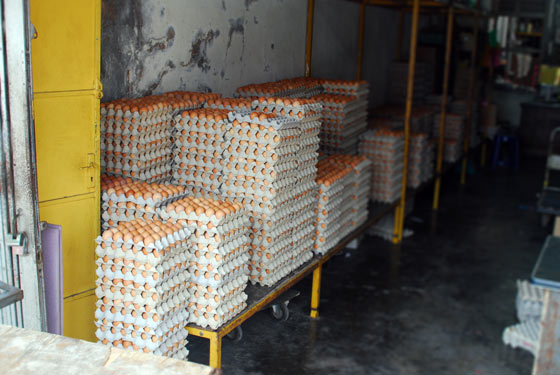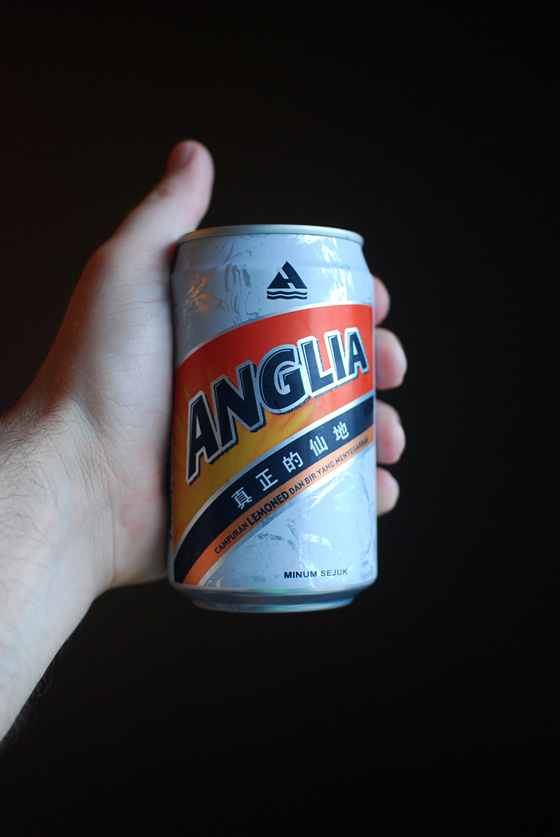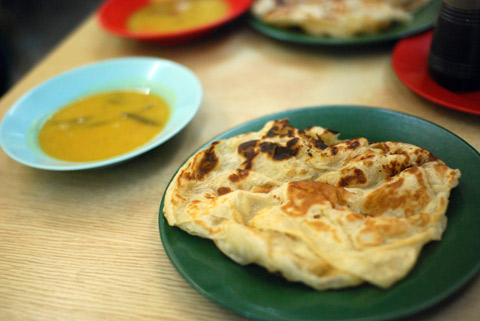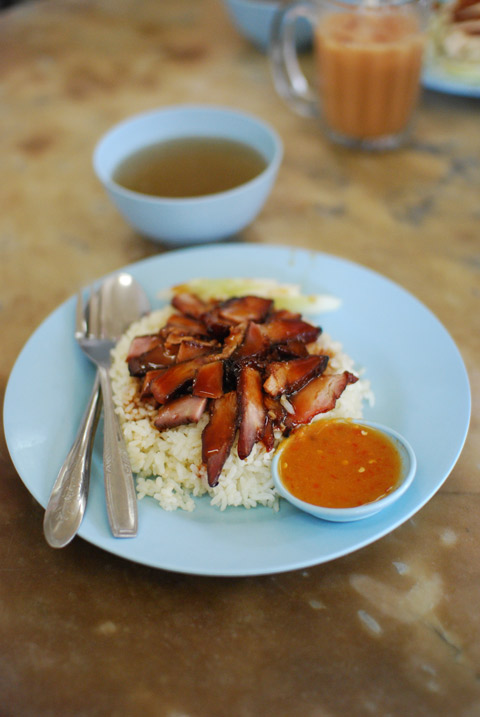
Self portrait with nasi campur at Restoran Siti Fatimah, Langkawi
Post Category → Malaysian Food
How to introduce your two year old to Malaysian street food.
1. Buy a street food.
2. Hand over the chopsticks.
So, I had a kid and thought that I should mention it for when she’s old enough to ask about why she’s not in any of the blog posts, which will be soon now that she can negotiate devices with screens and understands conceptually that the Internet exists, and it’s where Bananas in Pyjamas live. I’d been avoiding it until now so that I could hold back the unrelenting tide of parent blogger PR spam. If you think that I don’t care about your new seasons menu, imagine how little I care that your pram comes in a new shade of Viktor&Rolf.
There’s probably a few intervening steps in introducing you child to street food, such as trying to explain how she can use chopsticks or eat chilli, but frankly, I have no idea how any of that happened. It’s not like I’ve been recording every moment of this.
As much as I’d like to say this is why I’ve slowed down my writing, it’s really not. Food blogging is of as little importance as it ever was. It’s worth reading Jess Ho’s piece about breaking up with her other blog. I feel the same, although they’re also the perverse reasons that I push on with it.
Eggs, Penang
The logistics of food is endlessly interesting when you step outside the reach of the robotic hands of supermarket distribution. Along with the produce, transport is what adds a degree of regional variation to most markets. One of my most enduring memories of one market in Cambodia is seeing a Toyota Camry, whose backseat had been hastily waterproofed with plastic tarpaulins, filled to the ceiling with live snakehead fish.
There are certainly more preferable ways to transport food, but there is no perfect means to transport food, which is why the humble cargo bike (below) can continue to compete with every other vehicle on Penang to transport eggs.
Whenever I see a bike like that, I just want to follow it.
Anglia Shandy
“Brewer”:Guinness Anchor Berhad (Diageo/Asia Pacific Breweries-Heineken).
One of my dreams was to become Asia’s leading reviewer of canned shandy, the worst thing to happen to beer since the discovery of shandy. Today that dream is horribly realised.
GAB Says: “The real shandy. Malaysia’s pioneer shandy, since 1978, recently took on a new and refreshing image and look, giving it a more exciting, cooler and fun image while continuing to provide its drinkers a unique and refreshing drinking experience. It is a refreshing blend of fizzy lemonade and beer to be enjoyed on all occasions.”
I say: I hoped that this was a shandy that was built for Malaysia’s pioneers, a drink that smelled faintly of the keropok that injured Tunku Abdul Rahman as a child and Tan Cheng Lock‘s rubber business. The only pleasant feature of this drink is that it pours a beautiful golden amber, the nicest shade of soft drink that I have ever seen. Nose of lemon dishwashing liquid and malt is obliterated by a smoked orange finish that acridly lingers in your throat.
If Anglia pioneered something, that thing would be: Burnt Fanta.
ABV: 1%
Satay
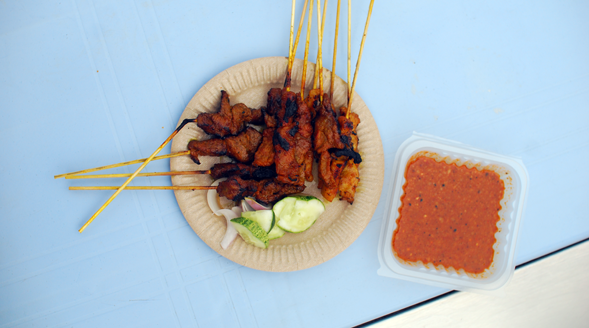
Chicken satay from Gurney Drive, Penang
Tek Sen, Penang
This is deep-fried pieces of boneless chicken coated in a crispy shell of batter, covered in mayonnaise straight from the jar. It’s a dish that the world’s food writers conveniently overlook when they heap well-deserved praise on restaurant Tek Sen in Penang because it doesn’t fit the clean narrative of tradition or authenticity that drives the de facto view of Malaysia through the lens of food magazines. There is no clear tradition of mayonnaise in Malay-Chinese cuisine but quite clearly, there should be. Tek Sen is licensed to drive that trend.
I didn’t eat at Tek Sen the last time that I was in Penang because it was too expensive. In hindsight that looks crazy, but four years ago, I was travelling around Asia on a budget of roughly $20 a day for two including transport and accommodation. It seems like a longer time ago. Spending $10 on a single meal was a tough decision when I could graze through several bowls of laksa a day for the same price. Now I spend more than $10 a day keeping myself sufficiently caffeinated. I eat at restaurants where $10 isn’t even an appropriate tip per person. The old me is probably horrified at the new me.
Maybe that is the only sign of being a moderately functioning adult.
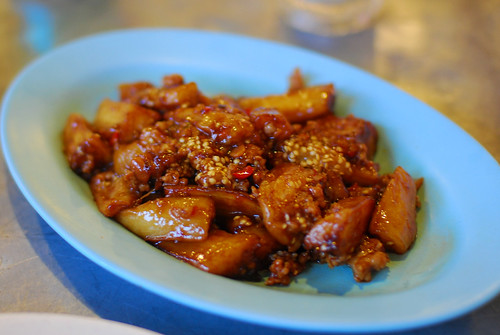
Eggplant with fermented bean paste
Four years on and the island is looking busier, more gentrified. The traffic is heavier and more Chinese shophouses are fenced off for renovation. The now World Heritage-listed core of Georgetown feels like it is beginning to take a similar path to Luang Prabang, where the centre of the city begins to hollow out for the needs of tourists, taking with it the atmosphere that tourists came for in the first place. There’s more buildings preserved as boutique hotels and the word “artisan” now attached to batik or carvings or basketry. It is still the greatest place on earth to eat on a fistful of dollars.

Mapo tofu has a relatively light touch of the numbing Szechuan mala sauce which lets the smoke from the wok work its way through.
Externally, Tek Sen remains much the same, a collection of reflective stainless tables encircled by battered metal stools within an airy, tiled shophouse. The menus smell like graphic design and are clearly translated into English, a small nod to gentrification.
Penang’s a different place when you’re meaningfully employed. I ate Tek Sen’s double-cooked pork on multiple occasions. The best $4 you’ll ever spend. The double-cooked pork – siew yuk – is sticky and sweet batons of pork belly, stirfried to add a dose of smoke. This is the only pork dish I’ve eaten where I’m keen to lick the thin slick of pork fat from the bottom of the plate. As much as this is the dish that drives people to Tek Sen rather than their liberal ideas about deep-frying and egg emulsions, Tek Sen has a menu where you can’t make mistakes.

Pea shoots with dried, salted fish. It’s umami-salty and satisfying.
Eat everything. The small plates mean that even a party of two can easily work through five dishes. Four people could eat almost half the menu.
Location: 18-20 Carnarvon Street, Georgetown, Penang
“It’s a minefield even for Asians”
I had dinner on Saturday at Poon’s Chinese Restaurant in Barkly Street, Footscray. It was the worst Cantonese meal that I’ve eaten in Melbourne. The service was gracious and friendly considering that they were packed and it was dirt cheap. The meal was a mistake but not an expensive one and it filled me with regret but not salmonella. The food was uniformly tasteless like some non-toxic, starchy glue.
Poon’s however, is popular enough to be ranked a local institution much of which seems to revolve around the ritual of regular dining in the same place over a period of decades. The result of a family decision where Friday night is fish and chips, Saturday night is Poon’s. Single sex groupings dining together, having the Boy’s Night Out with a table filled with Crownies; women on other tables sharing a bottle of Jacob’s Creek Chardonnay and splitting Poon’s gigantic (and suspiciously Chiko Roll-like) spring rolls. There were no chopsticks on offer, anywhere.
At a guess, it has been doing the same food in the same place for half a century and the punters love it. Here’s a review from Menulog:
i have been a ‘patron’ of ‘Poons’ for at least 40 years, and would not go anywhere else. The food is fresh, nutritional and very easy to eat. The variations on the Menu are wonderful.
The staff and Management have ALWAYS been good to me and i feel part of their family after all these years, at being treated as part of their family.
i only wish they could deliver to Carlton to where i live, but at least i get a chance to mix with some of the ‘cream of the crop people in our Society when i visit them regularly.
Thank you for allowing me to tell you this wonderful news about ‘Poons’. ( i tell everyone i go there and love it and the staff too )
Who in Australia cares about “Asian food” in a world where Poon’s is rating as well as Flower Drum or Lau’s on user-generated review sites?
When it comes to food from Asia, most Australians are happy with average food. “Chinese food” means a regionless choice of meat stir fried in your choice of bland starchy sauce. Most Australians are content with the local Thai joint doing the traffic light curries (red, green, yellow) straight from the bucket of Mae Ploy. Vietnamese means pho alone. Japanese is aseasonal and what rich people eat (except for sushi, which is no longer associated with Japan). The rest of Asia is a vague unknown, summarised in the thinner chapters of cookbooks with the word Oriental
in the title. Above all, the food must be “very easy to eat”. No bones, no heads, no need to even chew.
So Necia Wilden’s article in The Australian newspaper regarding her inability to find or discern premium Asian ingredients was no great surprise to me. Boneless and free from the shackles of mastication. I’m only bringing it up because of the interesting discussion it has spawned over at Progressive Dinner Party. Like Zoe, I read it in the physical newspaper. I paid good money for it in the hope that food journalism in The Australian (and coverage of food from Asia) would be better in 2009 under Lethlean and Wilden’s gaze. I haven’t bought an edition of The Australian since. If it’s been a bumper year for food writing in The Australian, apologies for not supporting it.
I’m not going to tackle the racism behind grouping food from Asia together into an undifferentiated and monolithic bloc, skipping between cuisines as if there was no need for specialist knowledge in any of them. Provincial food for The Australian, it seems, only comes from refined palates in Europe.
It’s the Chicken Tonight approach to food that also concerns me: if only I had the right stir-through sauce recommended to me as authentic, the curry would taste the same as at my hotel in Phuket. So how to come by this knowledge? Getting a recommendation from the person that owns the store is just not good enough, as Wilden puts it:
“How do I know this soy sauce is organic?” I ask the young woman in the Japanese grocery store near my home. “Because it says so on the label,” she says, pointing to the Japanese characters on the bottle’s posh paper wrapping. Ah, right.
The key, according to the article, is to get a chef to tell you what is good, preferably one with an Asian last name or a cookbook the size of a family sedan. Actually going out, buying a few things and then tasting them is not mentioned. You only learn to cook through your own experiences and your sense of taste is subtly different to everyone else and above all, should be trusted. If David Thompson recommends Megachef brand fish sauce but you enjoy $3 a bottle Tiparos, go with your own tastes. At most, experimenting with different brands will be less than $5 a hit.
Buying ingredients is no minefield as Tony Tan mentions in the article, at least in comparison to the minefields that I’ve seen built for Cambodians and by Cambodians. Ask the shopkeeper. Try different things. You won’t step on anything that will turn you, your children or your livestock into a fine pink mist. So who is this article meant to service? What is to gain from making cooking certain cuisines at home look more difficult and less satisfying?
Just to put on a particularly Bolshie hat, newspapers have so little to gain from pimping out fresh food – it is the Simon Johnson’s of the world that buy ads in the food sections of newspapers and not your local Vietnamese grocer. There is a need for newspapers to prop up a system that recommends branded goods over raw ingredients. If word got out that fresh ingredients make much more of a difference in cooking than processed ones, all hell would break loose. People would be smashing in the Lean Cuisine fridges in your local duopolist supermarket in a fit of rage.
Just to bring things back to the world of Poon’s rather than some parallel universe where people care about what they eat, The Australian’s food section is aimed squarely at the Poon’s market and not at me. It’s aimed at people who buy the best fish sauce as a display to others that they buy the best fish sauce rather than as a pungent condiment whose value is in its consumption. This is the food journalism for the people who have been eating the same Chinese food for decades and are unwilling or unable to try somewhere new without someone else validating and translating the experience for them.
Parachute Foodblogging 2: Restoran Nasi Kandar KL
Kuala Lumpur is the perfect town for stopover eating: parachuting into town for the few hours between flights. I’ve done it once before but this time was a bit more of a nostalgia trip. For me, breakfast in KL is synonymous with nasi kandar; Malaysian Tamil Muslim food from a cheap restaurant, leaden curries matched with feather-light roti.
Restoran Nasi Kandar KL on Jalan Tun Tan Cheng Lock, just around the corner from Petaling Street is by no means the greatest nasi kandar in town, but it feels like my nasi kandar. The grime-streaked yellow facade seems unchanged and the Indian Malaysian guy at the front counter still seems overwhelmingly pleased to see me. It was just between the cheap backpacker joint where I spent the most of my time in Malaysia and Pasar Seni station. The obvious place to stop on the way to eat somewhere else every day. They do an excellent roti canai: the accompanying curry is passable but the roti is spot on: buttery, both fluffy and elastic. It’s some of the best eating in transit that can be done.
Just in case roti is not enough, there is a decent kopitiam across the road with the usual jumble of vendors: a roast meat guy, various noodle soups and fried noodles stands that encircle a coffee shop. I hit up the pork and rice just in preparation for Cambodia.
Fatty rice but dry pork. I should have had that third roti.


